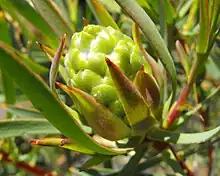| Leucadendron salicifolium | |
|---|---|
 | |
 | |
| Scientific classification | |
| Kingdom: | Plantae |
| Clade: | Tracheophytes |
| Clade: | Angiosperms |
| Clade: | Eudicots |
| Order: | Proteales |
| Family: | Proteaceae |
| Genus: | Leucadendron |
| Species: | L. salicifolium |
| Binomial name | |
| Leucadendron salicifolium (Salisb.) I.Williams | |
Leucadendron salicifolium, the common stream conebush, is a flower-bearing shrub belonging to the genus Leucadendron and forms part of the fynbos. The plant is native to the Western Cape where it occurs from Porterville to Kogelberg and Langeberg.[2]
Description
The shrub grows 3 m (9.8 ft) tall and flowers from July to September. The plant dies after a fire but the seeds survive. The seeds are stored in a toll on the female plant and only fall to the ground after a fire and are possibly spread by the wind. The plant is unisexual and there are separate plants with male and female flowers, which are pollinated by the wind.
Distribution and habitat
The plant grows mainly in rivers and seepage water at altitudes of 0–1,000 m (0–3,281 ft).[3] In English, it is known as the common stream conebush.[4] The tree's national number is 82.1.[5]
Gallery
References
- ↑ Rebelo, A.G.; Mtshali, H.; von Staden, L. (2020). "Leucadendron salicifolium". IUCN Red List of Threatened Species. 2020: e.T113170566A157953573. doi:10.2305/IUCN.UK.2020-3.RLTS.T113170566A157953573.en. Retrieved 8 September 2021.
- ↑ "Threatened Species Programme | SANBI Red List of South African Plants". redlist.sanbi.org. Retrieved 12 December 2021.
- ↑ "Delta-seed Conebushes". www.proteaatlas.org.za. Retrieved 12 December 2021.
- ↑ "Leucadendron salicifolium (Common stream conebush)". biodiversityexplorer.info. Retrieved 12 December 2021.
- ↑ "National List of Indigenous Trees".


